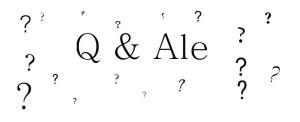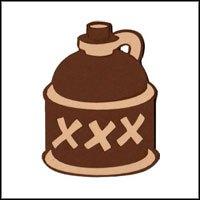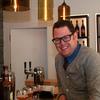
Today’s Q & Ale question was brought to me via search engines such as Google. I’ve actually seen some version of this question several times and thought I’d answer it as the first installment of Q & Ale.
Why are they called a double, triple, quadruple?
The “they” in question are the beers brewed, largely, by the Trappist monasteries of Belgium as well as the abbey affiliated ones. The styles have also become very popular with secular breweries throughout the world. Although no one knows for sure how they got their names, the most common answer has to do with the way alcohol products were traditionally marked. When the majority of people were illiterate the easiest way to mark the strength of whatever your were making/drinking was with an “X.” 1 was for lighter alcohol strength, with 2, 3, or more for stronger versions.

(Picture from moonshineheritage.com)
So, a X indicated a single, XX a double, XXX a Triple, and XXXX a quad. It’s in this tradition that these beers most likely got their names.
The MBAA (Master Brewers Association of the Americas) provides a more technical theory on how these beers earned their name based on the parti-gyle system of mashing. In this system, you drain off your first running of wort and keep it separate This leads to a first running with a fermentable sugar content of about 22.5%. The second wash (after the first has completely drained) would be less strong at around 15%. The final wash would end up with a sugar content of about 7.5%. Now if you work backwards, the double has 2x’s the sugar as the single and the triple has 3x’s the sugar as the single. Essentially, you’d have 3 beers of 3 different strengths brewed from one mash. While most people no longer use this system (they blend all the washes together), it might be a good historical explanation on how these styles got their names.
Some of the more common and erroneous theories revolve around the idea that a double has 2x’s the malt of a single and a triple, 3x’s the malt of a single. Or that they’re double or triple fermented. If this were the case, the alcohol levels would be significantly higher as “pounds of extra collected is linear,” according to Jamie Emerson, Executive Brewmaster of Full Sail Brewing. He believes the most likely reason involves ancient methods of brewing based around the above mentioned “parti-gyles” system. Jamie also contact one of his Belgian brewing friends and this is what he said:
“As far as I’m informed, this old designation was in the abbeys for the strength of the beer (and hence the strength of the wort used to make it). “Double” made with stronger wort and “Triple” with even stronger wort. The “Petite Bière” (litterally “Small Beer”) was made from the last sparging water and was a light beer for local consumption of the monks themselves.
Today these are only marketing words. It is pretty much referred that the “Double” are rather dark beers somewhere in the 6-8° alcohol and “Triple” are rather pale beers with higher alcohol contents (8° and above). But there is no strict rule for that.
And this is also often confused with “double fermentation” and “triple fermentation” (fermentation/ageing/repitching in bottle) which are even more only marketing fancy words.”
A single, sometimes called a “pater” beer, is usually a lower alcohol table beer reserved for the daily use of the monks. Witkap is one commerical brewery that makes a version of this style. To try the actual Trappist singles, you’ll have to go to the monastery’s cafe. These beers tend to range from 4.5% – 5.5% ABV.
A double, sometimes spelled “dubbel,” is usually a darker amber or brown beer with an ABV of 6%-7.5% Chimay Red and Rochefort 6 are two great and readily available versions.
A triple, sometimes spelled trippel or tripel, usually is a golden beer ranging from 8% to 9.5% (although there are some that go much higher). Triple is probably the most famous and commonly copied of the Trappist styles. Westmalle is considered to be the “king” of the triples and is fairly easy to find. Chimay White is also a great example.
A quadruple, or quad, is the highest alcohol version at 9%+ Although the majority tend to be dark brown, there are a few that fall in the golden/amber color range. Chimay Blue, Rochefort 10, Achel Extra Brune, and Gulden Draak 9000 are some interesting and varied versions of the quad style.
And that, most likely, is why they are called double, triple, or quad!
(Updated 10:16 PST on 3/19/2013)
(Updated: 09:45 PST on 3/18/2013)

